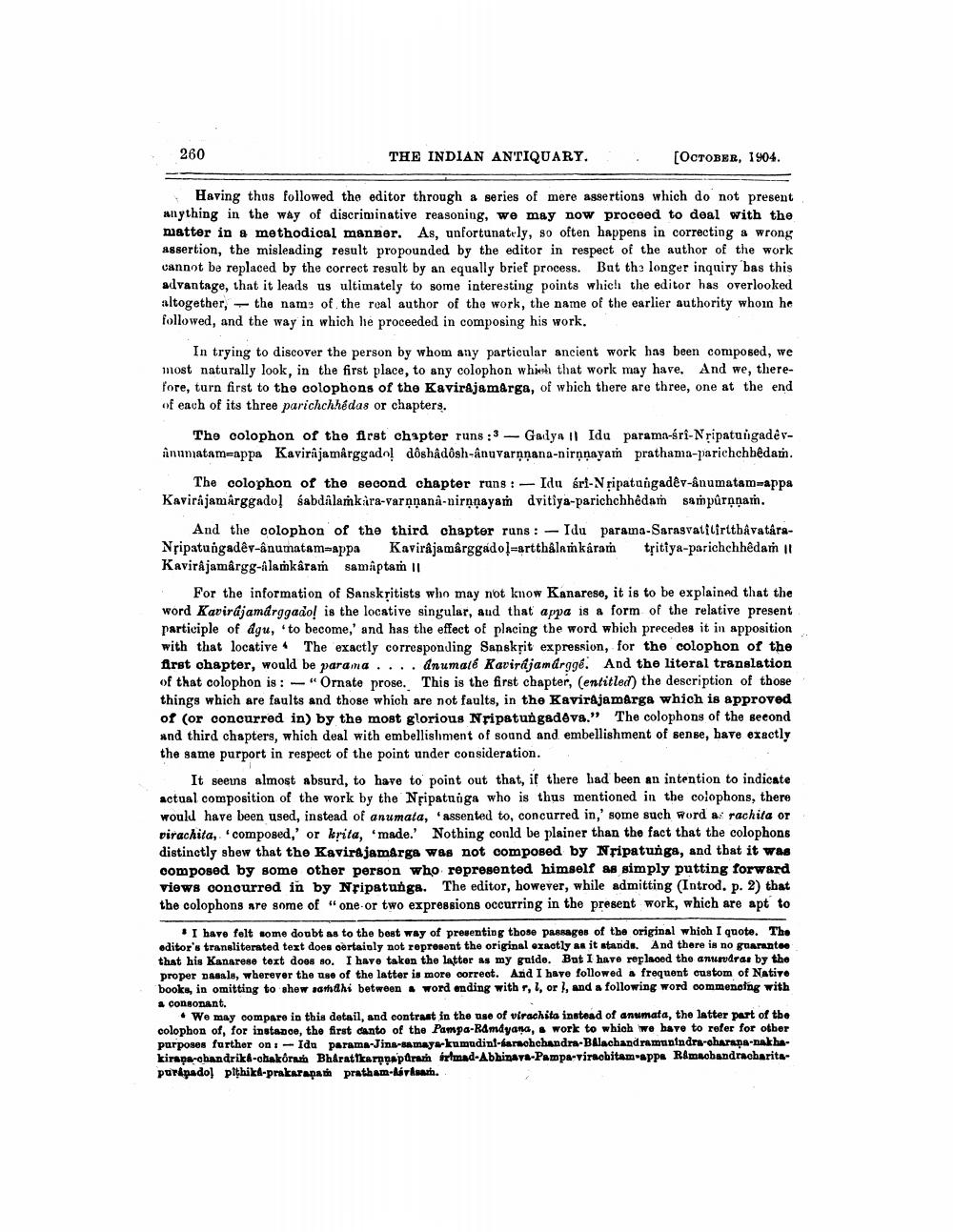________________
260
THE INDIAN ANTIQUARY.
[OCTOBER, 1904.
Having thus followed the editor through a series of mere assertions which do not present anything in the way of discriminative reasoning, we may now proceed to deal with the matter in a methodical manner. As, unfortunately, so often happens in correcting a wrong assertion, the misleading result propounded by the editor in respect of the author of the work cannot be replaced by the correct result by an equally brief process. But the longer inquiry bas this advantage, that it leads us ultimately to some interesting points which the editor has overlooked altogether, the name of the real author of the work, the name of the earlier authority whom he followed, and the way in which he proceeded in composing his work.
In trying to discover the person by whom any particular ancient work has been composed, we most naturally look, in the first place, to any colophon which that work may have. And we, therefore, turn first to the colophons of the Kavirajamarga, of which there are three, one at the end of each of its three parichchhédas or chapters.
The colophon of the first chapter runs :3 Gadya | Idu parama-sri-Nripatungadevânumatam-appa Kavirajamârggadol dôshâdôsh-ânuvarṇnana-nirnṇayam prathama-parichchhêdam.
The colophon of the second chapter runs: Idu śri-Nṛipatungadêv-ânumatam-appa Kavirajamarggado sabdalamkara-varṇnanâ-nirnṇayam dvitiya-parichchhêdam sampurnṇam.
And the colophon of the third chapter runs: Idu parama-SarasvatilirtthâvatâraNripatungadêv-ânumatam-appa Kavirajamarggade]-artthalakrah tritiya-parichchhêdam || Kavirajamargg-alamkâram samaptam II
For the information of Sanskritists who may not know Kanarese, it is to be explained that the word Kavirajamárggado! is the locative singular, and that appa is a form of the relative present participle of agu, 'to become,' and has the effect of placing the word which precedes it in apposition with that locative The exactly corresponding Sanskrit expression, for the colophon of the first chapter, would be parama.... anumalé Kavirájamárggé. And the literal translation of that colophon is: "Ornate prose. This is the first chapter, (entitled) the description of those things which are faults and those which are not faults, in the Kavirajamarga which is approved of (or concurred in) by the most glorious Nripatungadeva." The colophons of the second and third chapters, which deal with embellishment of sound and embellishment of sense, have exactly the same purport in respect of the point under consideration.
It seems almost absurd, to have to point out that, if there had been an intention to indicate actual composition of the work by the Nripatunga who is thus mentioned in the colophons, there would have been used, instead of anumata, assented to, concurred in,' some such word a rachita or virachita, composed,' or krita, made. Nothing could be plainer than the fact that the colophons distinctly shew that the Kavirajamarga was not composed by Nripatunga, and that it was composed by some other person who represented himself as simply putting forward views concurred in by Nripatunga. The editor, however, while admitting (Introd. p. 2) that the colophons are some of "one or two expressions occurring in the present work, which are apt to
I have felt some doubt as to the best way of presenting those passages of the original which I quote. The editor's transliterated text does certainly not represent the original exactly as it stands. And there is no guarantee that his Kanarese text does so. I have taken the latter as my guide. But I have replaced the anusdras by the proper nasals, wherever the use of the latter is more correct. And I have followed a frequent custom of Native books, in omitting to shew sam@hi between a word ending with r, l, or 7, and a following word commencing with a consonant.
We may compare in this detail, and contrast in the use of virachita instead of anumata, the latter part of the colophon of, for instance, the first canto of the Pampa-Ramayana, a work to which we have to refer for other purposes further on Idu parama-Jina-samaya-kumudini-farachchandra-Balachandramunindra-charana-nakhakirapa-chandrika-chakôram Bharatikarppapuram irmad-Abhinava-Pampa-virachitam-appa Ramachandracharitapurapadol pithika-prakarapaṁ pratham-lévisam.




